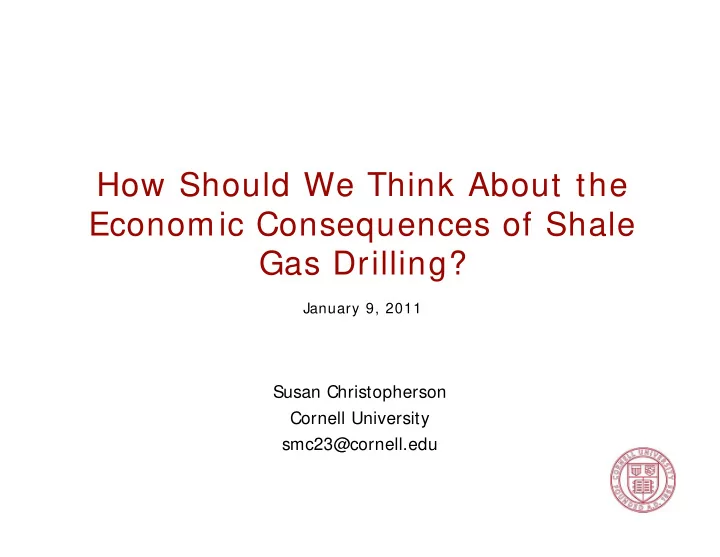

How Should We Think About the Economic Consequences of Shale Gas Drilling? January 9, 2011 Susan Christopherson Cornell University smc23@cornell.edu
Controversies Have Focused on Water
How Have Economic Impacts Been Assessed? The studies used to assess the economic consequences of HVHF gas drilling use input-output models based on investment per well to calculate expenditures and direct and indirect employment. These models: • indicate positive economic impacts because they project effects of investment in the region. • do not account for social, fiscal, or opportunity cost impacts, including negative impacts on existing industries. • do not consider the boom-bust cycle in natural resource extraction industries.
Why Are These Issues Important? Evidence of poor economic outcomes in resource dependent regions – the “resource curse”. Unanticipated costs arising from the industrial landscape that develops in shale gas drilling regions.
To Assess These Impacts We Need to Understand What Drives the Pace and Scale of Drilling Pace refers to the time frame within which gas extraction takes place. Scale refers to the number of wells drilled in a gas play annually. Source: Kelsey 2011
Case Studies Tell Us the Local Costs of Shale Gas Drilling During “Boom” Periods include: • Accelerated road maintenance • Traffic congestion from trucks (An estimated 890 to 1,340 truck trips per well site) • Higher public safety costs • Increased demand for health and education services • Increased demand on public administrative services (e.g. planning and zoning, permitting, assessments, housing assistance) • New service requirements, such as emergency response capacity and environmental monitoring and remediation.
How Will Local Costs Be Paid? Local residents may have to absorb whatever costs are not covered through state tax policy, local taxes and fees, or local agreements An illustration: SR 3020 in Towanda Township, Bradford County, Pennsylvania after a high volume of overweight drilling trucks and a Northeast winter (Photo: PennDOT Engineering District 4-0)
In a study of Sublette County, Jacquet found that public safety costs rose significantly with increases in drilling. The question is the threshold at which communities cannot respond effectively. Public Safety Impacts
A Regional Landscape Industrial
Why Do Rural Regions Dependent On Natural Resource Extraction Have Poor Development Outcomes? • Volatile revenue leads to poor government planning and lack of accountability. Yet, demands on government rise. • “Crowding out” -- the resource extraction industry works against economic diversification by creating an unfavorable environment (tourism) and increasing the cost of doing business (agriculture). • Housing and labor costs rise. • The resident population moves to lower cost and less congested areas. • After the initial “ramp-up” construction phase, there are few jobs and income inequality increases.
Some Proposed Policies • Slow it down to minimize cumulative impacts - through regulatory action and prevention of speculation. • Be transparent to minimize public anxiety and enable citizen input. • Plan across governments to minimize negative impacts from industrial infrastructure. • Be proactive in planning for ways to use this resource for regional economic development.
How Should We Think About the Economic Consequences of Shale Gas Drilling? January 9, 2011 Susan Christopherson Cornell University smc23@cornell.edu
Sample Workforce Flow through the drilling phases (ERG/Jacquet)
Boom-bust Cycle in Royalties, Business Incomes, Tax Revenues, and Jobs Dollars Years Adapted from Tim Kelsey (2011), "Annual Royalties in a Community".
The Faster the Pace, the Higher the Cumulative Costs The literature on “boomtowns” indicates that communities can adapt to a 5% increase in service demand but that governance and services break down if a 15% increase is required.
Well Development Phases Phase I (months per well, years for entire region) • Construct access roads, well pad, local collection pipeline • Drill & fracture well • Construct supporting facilities and services Phase I I (years or decades) • Truck water from well site, monitor natural gas production • Refracture well if necessary • Reclaim some disturbance Phase I I I Remove surface equipment, plug well • Restore landscape (Based on Jacquet, 2011)
Recommend
More recommend